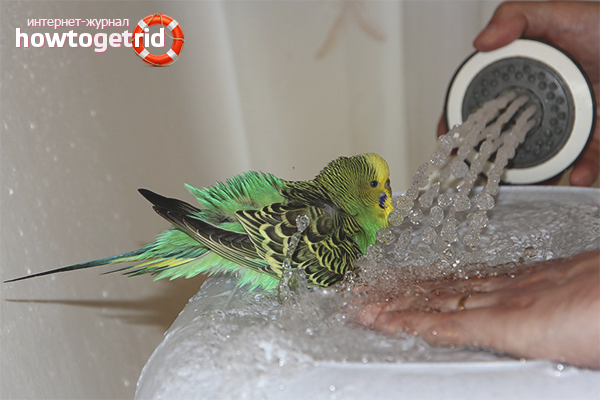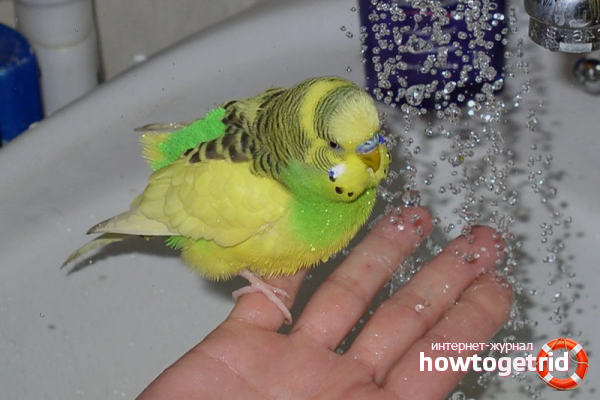The content of the article
Budgies are inherently clean birds, which means that basic care involves water procedures. Like any other business, swimming includes a number of important aspects that must be considered. Experienced breeders, through trial and error, have come up with effective methods of carrying out the procedure. Let's consider them in more detail.
Preparatory activities before swimming
- To bathe a parrot, grab it in your hands. If your pet doesn’t let you in, gently wrap the bird in a towel. After this, it is necessary to hold the bird by the area located just above the cheeks. Fix the body of the animal at the same time to prevent possible damage.
- Do not allow bright lighting, in the twilight the parrot behaves much calmer, so it will be easier to bathe it.
- To lather the pet, it is necessary to do this along the plumage, and then thoroughly rinse the composition with water. In no case do not use chemicals, even if the parrot is very dirty.
- If we are talking about pollution with oil, paint or other persistent substances, you need to soap the plumage several times and rinse well. Since birds clean their feathers on their own, they can be poisoned by chemicals. If the stained areas cannot be washed, they should be carefully trimmed.
Bathing budgies
- Bathhouse. You need to teach a parrot to bathing only after several weeks of adaptation in a new house (about 4-6 or more). First, get your pet's attention by placing a bright toy in a saucer of water. You can also put a lettuce leaf in the container. In the wild, birds do so in the dew. If your pet is interested, feel free to put him a bowl of water. It will be a great joy for a parrot to splash around on a sunny windowsill, so place the cage in an appropriate place.
- The fountain. You can please the pet and put for him a fountain in which water constantly murmurs, this will lead the parrot to an indescribable delight. For hand birds, you can use another method. If you need to wash your hands, put the bird on your shoulder and do hygiene. Perhaps the parrot itself will come closer to the crane and get under the water. In no case do not force the bird to swim forcibly, for her it will be a lot of stress.
- Wet grass. Parrots know how often they need to carry out water procedures. Therefore, leave a bath of water in the cage, give the animal the right to choose. As a rule, budgies prefer to swim in a hot period of time. Some birds just rub on wet grass. The grass must be soft, so it must first be thoroughly washed. If the parrot begins to rub, spreading feathers, then it's time for water procedures.
- Sand. In winter, it is recommended to fill the bathtub with a small amount (about 1 cm.) Of organic sand. In this way, the parrot joyfully dusts its feathers, cleansing of parasites. The composition is sold in pet stores, the cost of a bottle weighing 1 kg. varies in the range of 150-250 rubles.
- Talc. If the parrot is a type of pet that does not tolerate water, buy a baby talcum powder (powder) at the pharmacy without additional components or based on chamomile. Distribute the composition over the feathers of the animal and rub thoroughly, do not rinse. An alternative to talc is premium rye or wheat flour. Fill a deep bowl with loose composition and put in a cage.Some housewives prefer to mix flour and baby powder in equal proportions. Act on your own, the effect will not change for the worse.
Features of bathing parrots
Before bathing your pet, fill the bath with warm drinking water. During the procedures, the parrot will definitely take a few sips. The depth of water in the saucer should not be higher than the phalanx of the finger. You can also spray liquid over the bird’s head with a spray bottle, thereby simulating rain. It is important to consider that actions can scare the pet. If he starts to tweet and rush in alarm, you need to stop such events.
Take water quality seriously. An important element is the lamp above the cage during the cold season, as the pet needs to dry out after bathing. Be sure to ensure that there are no drafts. It is worth remembering that the method of water procedures is selected taking into account the nature of the bird. Bathing is rightfully considered an extremely fascinating sight for the owner and a pleasant process directly for the pet itself.
Rules for bathing budgies
When organizing water procedures, it is important to adhere to practical recommendations. Non-observance of the rules will not only not bring pleasure from swimming, but can also harm the health of the parrot.
- Water should be warm (it’s even warmer in the spray gun).
- Make sure there are no drafts.
- Adjust the depth of the water in the bath (not higher than the phalanx of the finger).
- The temperature in the room should not be lower than 20 degrees.
- It is important to use filtered water, because parrots have a habit of drinking it during water procedures.
- Do not force the bird to swim violently.
- At the end of the procedure, remove the container of water from the cage so that the parrot does not have the opportunity to drink it.
Practical recommendations
- For swimming, you can add a little chamomile infusion to the water. Such a decoction will be useful for digestion and for the skin of a parrot.
- After water procedures, do not dry the bird with a hairdryer. In the armpits, parrots have a sensitive dermis. Any exposure to thermal devices adversely affects the skin.
- Upon completion of all manipulations, leave the pet to dry on a thick terry towel or paper towel. Do not forbid the bird to rush along the cage, so the pet removes residual moisture from the feathers, putting itself in order.
- It is important to remember forever that parrots are prone to frequent colds. For this reason, it is recommended to close all windows in the house and turn off the split system. The recommendation is also relevant for hot summer days.
- If water procedures are carried out in winter, after the bird is driven into the house, take the cage to heating radiators. Warm air will help the pet dry faster and prevent the development of inflammation.
- It should be understood that the frequency of bathing depends on the nature of the pet and its susceptibility to water. It is not recommended to carry out the procedures more than once a month in the winter and three times a month in the summer.
- During bathing, make sure that water or soapy water does not get into the eyes and nostrils of the bird. If you couldn’t avoid a mistake and the liquid got into forbidden places, carefully take the parrot in your hand and lower it with your head down. Keep the bird in this position for no longer than 10 seconds.
It’s easy to wash a parrot at home if you have practical knowledge and follow the instructions. Leave the bird splashing in warm water or clean the feathers with baby talcum powder. Perform water treatments with wet grass or fortified sand. Do not violate the temperature regime, do not allow drafts.
Video: how to bathe a budgie












Submit